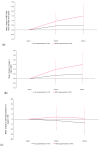Multiple Micronutrients and Docosahexaenoic Acid Supplementation during Pregnancy: A Randomized Controlled Study
- PMID: 32823606
- PMCID: PMC7468952
- DOI: 10.3390/nu12082432
Multiple Micronutrients and Docosahexaenoic Acid Supplementation during Pregnancy: A Randomized Controlled Study
Abstract
Maternal dietary intake during pregnancy needs to meet increased nutritional demands to maintain metabolism and to support fetal development. Docosahexaenoic acid (DHA) is essential for fetal neuro-/visual development and in immunomodulation, accumulating rapidly within the developing brain and central nervous system. Levels available to the fetus are governed by the maternal diet. In this multicenter, parallel, randomized controlled trial, we evaluated once-daily supplementation with multiple micronutrients and DHA (i.e., multiple micronutrient supplementation, MMS) on maternal biomarkers and infant anthropometric parameters during the second and third trimesters of pregnancy compared with no supplementation. Primary efficacy endpoint: change in maternal red blood cell (RBC) DHA (wt% total fatty acids) during the study. Secondary variables: other biomarkers of fatty acid and oxidative status, vitamin D, and infant anthropometric parameters at delivery. Supplementation significantly increased RBC DHA levels, the omega-3 index, and vitamin D levels. Subscapular skinfold thickness was significantly greater with MMS in infants. Safety outcomes were comparable between groups. This first randomized controlled trial of supplementation with multiple micronutrients and DHA in pregnant women indicated that MMS significantly improved maternal DHA and vitamin D status in an industrialized setting-an important finding considering the essential roles of DHA and vitamin D.
Keywords: docosahexaenoic acid; long-chain polyunsaturated fatty acids; maternal biomarkers; micronutrients; neurodevelopment; pregnant women; supplementation; vitamin D.
Conflict of interest statement
S.M. and E.S. are employed by Bayer consumer Care AG. The authors (M.M., C.N., C.M., S.D.F., M.D.P., R.C., M.P., V.S., I.C.) declare no conflicts of interest.
Figures



References
-
- Cazzola R., Russo-Volpe S., Miles E.A., Rees D., Banerjee T., Roynette C.E., Wells S.J., Goua M., Wahle K.W., Calder P.C., et al. Age-and dose-dependent effects of an eicosapentaenoic acid-rich oil on cardiovascular risk factors in healthy male subjects. Atherosclerosis. 2007;193:159–167. doi: 10.1016/j.atherosclerosis.2006.06.008. - DOI - PubMed
-
- Institute of Medicine . Dietary Reference Intakes for Calcium and Vitamin D. The National Academies Press; Washington, DC, USA: 2011. - PubMed

